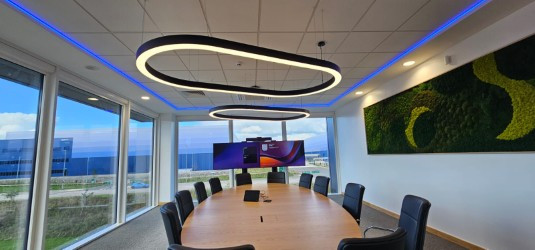The evolution and promise of solar power
Solar energy has transformed from a niche technology to a rapidly growing industry, poised to revolutionise the way we power our world. Today, the solar power industry is booming and it will continue to significantly impact the construction sector in the way we design and build in the future, writes John Ridgeway.
According to the International Energy Agency (IEA), global solar PV capacity reached a staggering 843 GW (gigawatts) at the end of 2023, with a record-breaking 330 GW added that year alone. This incredible growth has been driven primarily by lower costs. Solar panel prices have also plummeted by over 80% in the past decade, making them increasingly cost-competitive with traditional energy sources.
Many countries are also offering financial incentives like feed-in tariffs and tax breaks, making solar power a more attractive option for homeowners and businesses. Furthermore, growing awareness of climate change and the need for clean energy sources has driven public support for solar energy.
This growth is evident across the globe. China remains the world's leading solar power producer, followed by the United States, the European Union and India. However, significant growth is also being seen in developing countries like Vietnam, Brazil and Morocco. These regions are recognising the immense potential of solar power to meet their growing energy demands and create a more sustainable future.
The impact of solar power on construction
The growth of the solar power industry will necessitate the development of specialised skills and knowledge within the construction workforce. This will include training in rooftop solar panel installation to create a better understanding of building-integrated photovoltaics (BIPV) integration as well as new electrical codes and safety protocols for connecting solar systems to the grid.
As sustainability continues to become a top priority in construction, the use of solar power will increasingly become a key consideration for new buildings. This will result in closer partnerships between architects, involved with designing buildings that optimise solar panel placement and maximise energy generation.
Engineers are likely to see an increase in the need to deliver structurally integrated solar solutions into building designs and ensuring electrical system compatibility, while construction companies must develop expertise in installing solar systems.
All of this represents positive growth. The booming solar industry is creating new job opportunities in the construction sector, for trained professionals specialising in safe and efficient rooftop and BIPV installations. Technical experts who design solar systems based on building needs and energy requirements and professionals who maintain and troubleshoot existing solar installations, will also be in demand.
This growth will further contribute to the green economy and provide exciting career paths for skilled professionals in the construction industry. The prefabrication of building components with integrated solar panels is a growing trend. This allows for faster construction times where prefabricated components can be quickly installed on-site. Manufacturing solar panels and building components off-site ensures higher quality and consistency. Prefabrication also allows for a seamless integration of solar technology into the building envelope. This trend will reshape construction processes, requiring an adaptation to new methods and technologies for solar integration.
The diverse applications of solar power
While rooftop solar installations on homes and businesses remain a major market segment, the industry is expanding its reach in several other areas. Large-scale solar farms are generating electricity for entire communities. These projects are becoming increasingly cost-effective and are playing a crucial role in transitioning to renewable energy sources.
Building-integrated photovoltaics (BIPV), as already mentioned, are solar panels incorporated directly into the building envelope. This aesthetically pleasing approach offers both energy generation and architectural benefits.
Solar power is also providing clean energy solutions in remote locations where grid access is limited, improving lives and promoting sustainable development. Furthermore, electric vehicles powered by solar energy, either through direct integration or grid-charged batteries, are gaining traction, contributing to a cleaner transportation sector.
All this means that the future of solar power promises exciting possibilities. Technological advancements and economies of scale are likely to further drive down the cost of solar panels, making them even more accessible.
Research and development will lead to even more efficient solar cells, capturing more sunlight and generating more electricity per square metre. We will also see energy storage advancements, with the development of cost-effective and long-duration solutions for maximising solar energy use and addressing intermittency issues.
The future of solar power, does indeed look very exciting, particularly when you consider that it started from humble beginnings. The story of solar power started in 1839 with the discovery of the photovoltaic effect by French physicist Alexandre Edmond Becquerel. This ground-breaking discovery laid the foundation for converting sunlight directly into electricity. However, early solar cells were incredibly inefficient and expensive, hindering their widespread adoption.
The 20th century witnessed advancements in solar cell technology, with the invention of the silicon solar cell in 1954 marking a significant milestone. However, the high cost of these cells limited their use primarily for powering satellites and remote applications.
The 1970s oil crisis served as a wake-up call, highlighting the need for alternative energy sources. This spurred significant investment in solar research and development, leading to a gradual decline in production costs.
The birth of the modern solar industry can be traced back to the late 1990s and early 2000s. Governments around the world began implementing policies and incentives to promote solar energy adoption. Technological advancements also played a crucial role, with advancements in thin-film solar cells and manufacturing processes further reducing costs and improving efficiency.
The journey of solar power from a scientific curiosity to a global industry is a testament to human ingenuity and our growing commitment to a sustainable future. While challenges remain regarding energy storage and grid integration, the future of solar power shines bright.
As the industry continues to evolve, we can expect solar energy to play an increasingly central role in powering our homes, businesses and communities. With continued innovation, collaboration and a focus on sustainability, solar power has the potential to revolutionise the way we generate and consume energy, leaving a lasting positive impact on our planet for generations to come.
Additional Blogs

The changing face of workplace AV and what FM managers need to know
In today’s hybrid workplaces, facilities managers can no longer treat audio-visual systems as background infrastructure - they are now mission-critical assets that directly influence productivity,...
Read moreConstruction’s obsession with blame instead of learning
Construction is one of the most technically advanced industries in the built environment, yet culturally it often behaves like one of the least reflective. When things go wrong and they frequently...
Read more

How risk Is routinely pushed down the supply chain
Risk is an unavoidable part of construction. Every project involves uncertainty around ground conditions, weather, design coordination, procurement, labour and programme. Yet while risk is inherent,...
Read more